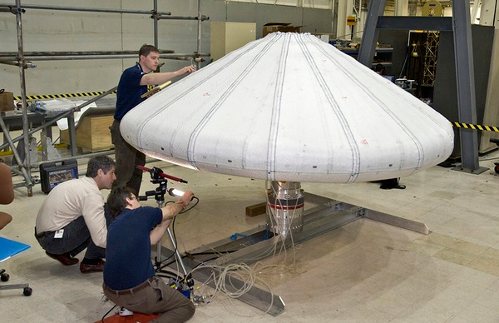
Last week was tested in an inflatable heat shield for the spacecraft, which demonstrated the potential of these light and flexible device intended to protect ships in the atmosphere while returning to Earth. Traditional thermal protection is a solid surface, which is either disconnected from the apparatus (in the case of the rovers sent to Mars), or gradually destroyed in the atmosphere. These panels are heavy and limit the payload available ship. Dimensions screens also limited, because they must fit in a space vehicle. Shields in the form of inflatable structures in the theory can solve the identified problems, because it is relatively lightweight and compact when folded. The new development called "Inflatable multiple transport experiment" (Inflatable Re-entry Vehicle Experiment, IRVE), was successfully tested with a small rocket, launched from a U.S. spaceport Wallops (Wallops Flight Facility) at Wallops Island, Virginia. The missile broke the 218 miles in 4 minutes of flight before the panel weight 40 kg, packed in 40-cm container, separated. Then, using pressurized nitrogen heat shield took the form of "hats" of the fungus with a diameter of 3 m. Carrying a payload that includes the navigation and gather data about the flight electronics, IRVE passed through Earth's atmosphere at supersonic speeds. Engineers expected excess of 5 swings (1 Mach is the speed of sound), or 1.7 km / s, but the final figures will be known after a full analysis of the data. How has warmed the surface of the shield, when he turned on the water of the Atlantic Ocean, not known for certain, although the Project Manager, Mary-Beth Васк (Mary-Beth Wusk) from Langley Research Center (Langley Research Center) NASA in Hampton spoke about the values of above 140 ° C. The shield is made of several layers of heat-resistant material woven with the use of thin ceramic fibers, closing a bag made of silicon coated with Kevlar in the form of ballona.Konstruktsiya screen is a cross between a parachute and the balloon and is known as "Ballut. A number of companies and government agencies have been developing Ballut and other inflatable screens for many years, including the company Andrews Space of Seattle, Washington. Temperature, which can withstand the shield depends on its size, says the chief engineer at Langley, Robert Dillman (Robert Dillman). Large surface area provides a lower rate of fall of the apparatus and increases the efficiency of the distribution of heat load. "It's like waving racket ping-pong in the air, first forward edge, and then the plane - leads analogy Dillman. - It distributes the energy over a larger area."
Because inflatable billboards may be wider than the carrier of their rocket, they are able to maintain a large mass in comparison with traditional protective screens. And their own light weight allows the ship to carry a larger amount of payload. According Dillmana, the ease of the new development will be fitting for the preparation of the mission to the Red Planet, because at such distances matter weight of the goods is critical: "If you want to send to Mars, more equipment, you want to apply creativity, or to draw attention to the inflatable structures. IRVE fully able to cope with voyages to Mars or Titan, as well as to return something to the International Space Station. Shield will work wherever there is atmosphere, "- adds an engineer. However, the development has yet to feel the heat resistance. "It was just a test flight, and the temperature, which will meet on board the interplanetary speed is not achieved. We have to work on to create a fully functional version IRVE", - summary Dillman. The team hopes that the next test flight will take place in early 2012.
Комментариев нет:
Отправить комментарий